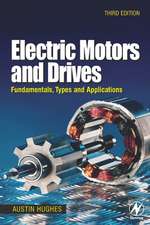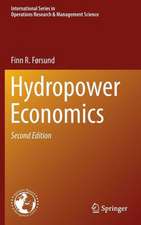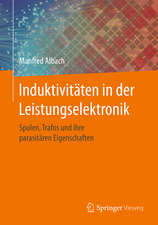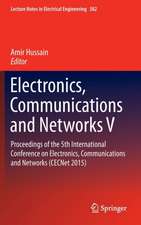Digital Control of Electrical Drives: Power Electronics and Power Systems
Autor Slobodan N. Vukosavicen Limba Engleză Paperback – 8 sep 2011
Digital Control of Electrical Drives helps the reader acquire practical skills in designing discrete-time speed and position controllers. Each chapter is followed by a set of Matlab® and Simulink® tools which help readers master the phases of design, tuning, simulation, and evaluation of discrete time controllers, and foresee the effects of control solution on the overall motion control system. Readers will also understand the present performance limits of digital motion controllers.
| Toate formatele și edițiile | Preț | Express |
|---|---|---|
| Paperback (1) | 643.84 lei 6-8 săpt. | |
| Springer Us – 8 sep 2011 | 643.84 lei 6-8 săpt. | |
| Hardback (1) | 651.51 lei 6-8 săpt. | |
| Springer Us – 22 aug 2007 | 651.51 lei 6-8 săpt. |
Din seria Power Electronics and Power Systems
- 18%
 Preț: 944.19 lei
Preț: 944.19 lei -
 Preț: 487.37 lei
Preț: 487.37 lei - 20%
 Preț: 630.01 lei
Preț: 630.01 lei - 15%
 Preț: 648.56 lei
Preț: 648.56 lei - 18%
 Preț: 1113.89 lei
Preț: 1113.89 lei - 18%
 Preț: 1120.99 lei
Preț: 1120.99 lei - 18%
 Preț: 950.33 lei
Preț: 950.33 lei - 18%
 Preț: 1981.53 lei
Preț: 1981.53 lei - 15%
 Preț: 638.43 lei
Preț: 638.43 lei - 18%
 Preț: 1660.95 lei
Preț: 1660.95 lei - 18%
 Preț: 940.87 lei
Preț: 940.87 lei - 15%
 Preț: 637.46 lei
Preț: 637.46 lei - 18%
 Preț: 949.55 lei
Preț: 949.55 lei - 18%
 Preț: 953.65 lei
Preț: 953.65 lei - 18%
 Preț: 953.97 lei
Preț: 953.97 lei - 18%
 Preț: 944.67 lei
Preț: 944.67 lei - 15%
 Preț: 634.32 lei
Preț: 634.32 lei - 18%
 Preț: 832.78 lei
Preț: 832.78 lei - 18%
 Preț: 945.30 lei
Preț: 945.30 lei - 18%
 Preț: 1239.85 lei
Preț: 1239.85 lei - 15%
 Preț: 642.18 lei
Preț: 642.18 lei - 18%
 Preț: 1656.08 lei
Preț: 1656.08 lei - 18%
 Preț: 953.65 lei
Preț: 953.65 lei - 18%
 Preț: 1554.09 lei
Preț: 1554.09 lei - 18%
 Preț: 1657.03 lei
Preț: 1657.03 lei - 18%
 Preț: 951.47 lei
Preț: 951.47 lei - 18%
 Preț: 888.31 lei
Preț: 888.31 lei - 18%
 Preț: 1219.01 lei
Preț: 1219.01 lei - 18%
 Preț: 893.53 lei
Preț: 893.53 lei - 18%
 Preț: 942.94 lei
Preț: 942.94 lei - 18%
 Preț: 1110.24 lei
Preț: 1110.24 lei - 15%
 Preț: 641.85 lei
Preț: 641.85 lei
Preț: 643.84 lei
Preț vechi: 757.46 lei
-15% Nou
Puncte Express: 966
Preț estimativ în valută:
123.20€ • 131.74$ • 102.72£
123.20€ • 131.74$ • 102.72£
Carte tipărită la comandă
Livrare economică 18 aprilie-02 mai
Preluare comenzi: 021 569.72.76
Specificații
ISBN-13: 9781441938541
ISBN-10: 1441938540
Pagini: 368
Ilustrații: XII, 353 p.
Dimensiuni: 155 x 235 x 19 mm
Greutate: 0.51 kg
Ediția:2007
Editura: Springer Us
Colecția Springer
Seria Power Electronics and Power Systems
Locul publicării:New York, NY, United States
ISBN-10: 1441938540
Pagini: 368
Ilustrații: XII, 353 p.
Dimensiuni: 155 x 235 x 19 mm
Greutate: 0.51 kg
Ediția:2007
Editura: Springer Us
Colecția Springer
Seria Power Electronics and Power Systems
Locul publicării:New York, NY, United States
Public țintă
ResearchCuprins
Speed Control.- Basic Structure of the Speed Controller.- Parameter Setting of Analog Speed Controllers.- Digital Speed Control.- Digital Position Control.- The Position Controller with Integral Action.- Trajectory Generation and Tracking.- Torsional Oscillations and the Antiresonant Controller.
Recenzii
From the reviews:
“This book is written for practicing engineers, advanced undergraduates, and graduate students interested in motion control who wish to understand electrical drives and drive control.” (IEEE Control Systems and Magazine, Vol. 30, June, 2010)
“This book is written for practicing engineers, advanced undergraduates, and graduate students interested in motion control who wish to understand electrical drives and drive control.” (IEEE Control Systems and Magazine, Vol. 30, June, 2010)
Textul de pe ultima copertă
Digital Control of Electrical Drives offers insight into electric drives and their usage in motion control environment. It provides links among electrical machine and control theory, practical hardware aspects, programming issues, and application-specific problems. The book prepares the reader to understand the key elements of motion control systems, analyze and design discrete-time speed and position controllers, set adjustable feedback parameters, and evaluate closed-loop performances. Basic engineering principles are used to derive the controller structure in an intuitive manner, so that designs are easy to comprehend, modify, and extend.
Digital Control of Electrical Drives helps the reader acquire practical skills in designing discrete-time speed and position controllers. Each chapter is followed by a set of Matlab® and Simulink® tools which help readers master the phases of design, tuning, simulation, and evaluation of discrete time controllers, and foresee the effects of control solution on the overall motion control system. Readers will also understand the present performance limits of digital motion controllers.
Digital Control of Electrical Drives helps the reader acquire practical skills in designing discrete-time speed and position controllers. Each chapter is followed by a set of Matlab® and Simulink® tools which help readers master the phases of design, tuning, simulation, and evaluation of discrete time controllers, and foresee the effects of control solution on the overall motion control system. Readers will also understand the present performance limits of digital motion controllers.
Caracteristici
Provides broad insights into problems of coding control algorithms on a DSP platform Includes a set of Simulink simulation files (source codes) which permits readers to envisage the effects of control solutions on the overall motion control system Bridges the gap between control analysis and industrial practice















